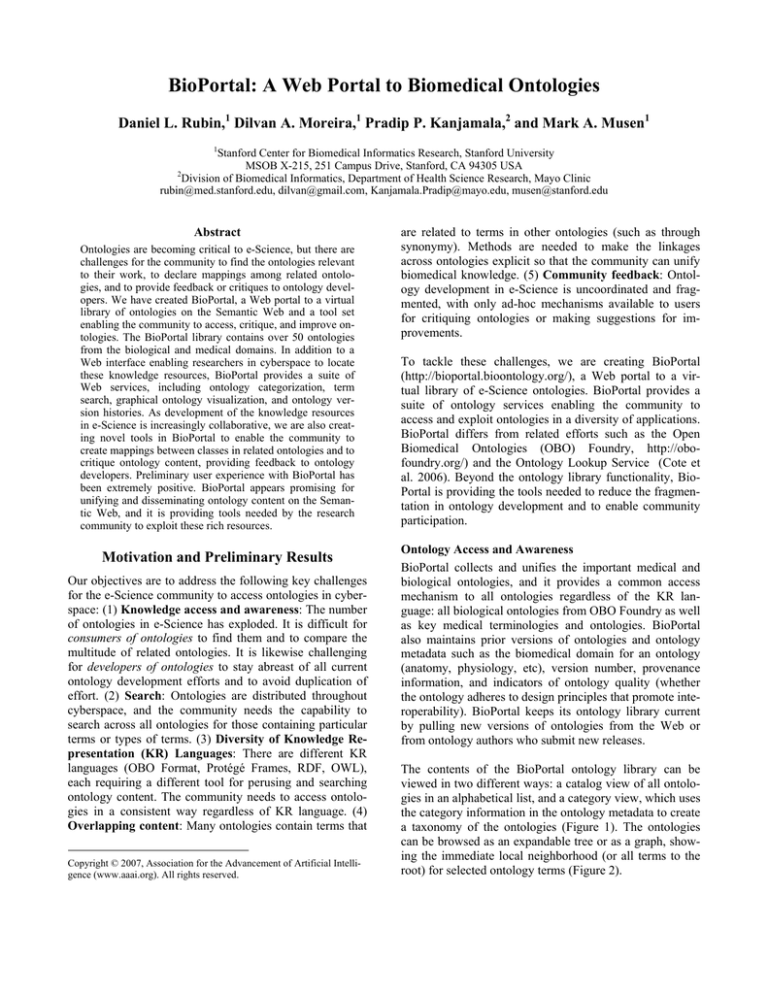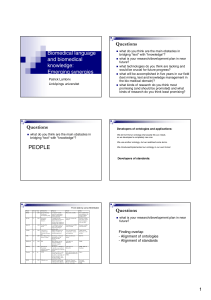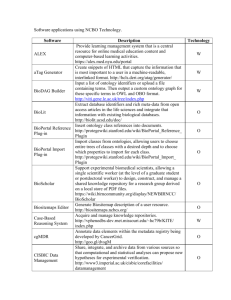
BioPortal: A Web Portal to Biomedical Ontologies
Daniel L. Rubin,1 Dilvan A. Moreira,1 Pradip P. Kanjamala,2 and Mark A. Musen1
1
Stanford Center for Biomedical Informatics Research, Stanford University
MSOB X-215, 251 Campus Drive, Stanford, CA 94305 USA
2
Division of Biomedical Informatics, Department of Health Science Research, Mayo Clinic
rubin@med.stanford.edu, dilvan@gmail.com, Kanjamala.Pradip@mayo.edu, musen@stanford.edu
Abstract
Ontologies are becoming critical to e-Science, but there are
challenges for the community to find the ontologies relevant
to their work, to declare mappings among related ontologies, and to provide feedback or critiques to ontology developers. We have created BioPortal, a Web portal to a virtual
library of ontologies on the Semantic Web and a tool set
enabling the community to access, critique, and improve ontologies. The BioPortal library contains over 50 ontologies
from the biological and medical domains. In addition to a
Web interface enabling researchers in cyberspace to locate
these knowledge resources, BioPortal provides a suite of
Web services, including ontology categorization, term
search, graphical ontology visualization, and ontology version histories. As development of the knowledge resources
in e-Science is increasingly collaborative, we are also creating novel tools in BioPortal to enable the community to
create mappings between classes in related ontologies and to
critique ontology content, providing feedback to ontology
developers. Preliminary user experience with BioPortal has
been extremely positive. BioPortal appears promising for
unifying and disseminating ontology content on the Semantic Web, and it is providing tools needed by the research
community to exploit these rich resources.
Motivation and Preliminary Results
Our objectives are to address the following key challenges
for the e-Science community to access ontologies in cyberspace: (1) Knowledge access and awareness: The number
of ontologies in e-Science has exploded. It is difficult for
consumers of ontologies to find them and to compare the
multitude of related ontologies. It is likewise challenging
for developers of ontologies to stay abreast of all current
ontology development efforts and to avoid duplication of
effort. (2) Search: Ontologies are distributed throughout
cyberspace, and the community needs the capability to
search across all ontologies for those containing particular
terms or types of terms. (3) Diversity of Knowledge Representation (KR) Languages: There are different KR
languages (OBO Format, Protégé Frames, RDF, OWL),
each requiring a different tool for perusing and searching
ontology content. The community needs to access ontologies in a consistent way regardless of KR language. (4)
Overlapping content: Many ontologies contain terms that
Copyright © 2007, Association for the Advancement of Artificial Intelligence (www.aaai.org). All rights reserved.
are related to terms in other ontologies (such as through
synonymy). Methods are needed to make the linkages
across ontologies explicit so that the community can unify
biomedical knowledge. (5) Community feedback: Ontology development in e-Science is uncoordinated and fragmented, with only ad-hoc mechanisms available to users
for critiquing ontologies or making suggestions for improvements.
To tackle these challenges, we are creating BioPortal
(http://bioportal.bioontology.org/), a Web portal to a virtual library of e-Science ontologies. BioPortal provides a
suite of ontology services enabling the community to
access and exploit ontologies in a diversity of applications.
BioPortal differs from related efforts such as the Open
Biomedical Ontologies (OBO) Foundry, http://obofoundry.org/) and the Ontology Lookup Service (Cote et
al. 2006). Beyond the ontology library functionality, BioPortal is providing the tools needed to reduce the fragmentation in ontology development and to enable community
participation.
Ontology Access and Awareness
BioPortal collects and unifies the important medical and
biological ontologies, and it provides a common access
mechanism to all ontologies regardless of the KR language: all biological ontologies from OBO Foundry as well
as key medical terminologies and ontologies. BioPortal
also maintains prior versions of ontologies and ontology
metadata such as the biomedical domain for an ontology
(anatomy, physiology, etc), version number, provenance
information, and indicators of ontology quality (whether
the ontology adheres to design principles that promote interoperability). BioPortal keeps its ontology library current
by pulling new versions of ontologies from the Web or
from ontology authors who submit new releases.
The contents of the BioPortal ontology library can be
viewed in two different ways: a catalog view of all ontologies in an alphabetical list, and a category view, which uses
the category information in the ontology metadata to create
a taxonomy of the ontologies (Figure 1). The ontologies
can be browsed as an expandable tree or as a graph, showing the immediate local neighborhood (or all terms to the
root) for selected ontology terms (Figure 2).
sentation of terms (synonyms, terms in different language,
lexical variations) and the relations between them.
The unification of ontologies in BioPortal also enables it to
make all ontology content accessible to the Semantic
Web—we are currently publishing all terms in BioPortal to
the Web using Uniform Resource Identifiers (URI) so that
diverse applications throughout cyberspace can refer to the
breadth of biomedical entities in these ontologies.
Figure 1. BioPortal ontology library displayed in the
category view, showing a taxonomy of ontologies organized according to the type of the ontology.
Overlapping Content
There are many ontologies with similar entities; for example, there are several ontologies and terminologies for human anatomy. In e-Science, it is critical to be able to make
statements about how entities in one ontology relate to
those in another ontology. A biologist might want to say
that “a white blood cell hasPart nucleus.” This statement
would require a mapping from the “white blood cell” (Cell
Type ontology) class through a hasPart relation to the
“nucleus” (Gene Ontology) class. BioPortal will store
mappings between classes in related ontologies so that
users can make such statements about semantically-related
classes. The mappings will also include metadata (such as
the creator or type of automated mapping method) so that
users of the mappings can filter them according to established trust relationships. The mappings will enable applications to bring together diverse data on the Semantic Web
that was annotated with different, yet semantically-related
ontology terms.
BioPortal is built using a service-oriented architecture,
encapsulating the breadth of its functionality as a set of
services. In addition to a Web application layer for users,
there is a Web services layer enabling agents in cyberspace
to access the rich BioPortal ontology content.
Ontology Search
Users can search for terms within an ontology or across all
BioPortal ontologies. Searches can be restricted to class
names, properties or other attributes. Searches can also be
based on exact matches or soundex. In addition, users can
search ontology metadata to find particular types of ontologies. BioPortal contains a master index of all ontology
content and metadata to streamline these searches.
Unification of KR Languages
Biomedical ontologies are created in a variety of KR languages, such as OBO Format, OWL, and Protege frames.
BioPortal translates ontologies in the different KR languages into a common representation so that it can unify
the diverse ontology content in cyberspace. This functionality is critical to search across all ontologies. To unify
the diverse content, the BioPortal ontology library adopts a
common representation of the terminological aspects of
ontologies—the Common Terminological Services (CTS)
model. Common terminological aspects include the repre-
Figure 2. Ontology visualization in BioPortal. Ontologies are shown both as an expandable tree (left) as well
as a local neighborhood graph (right; the selected class
is highlighted in yellow).
Community Feedback
A particularly important role we see BioPortal fulfilling in
the ontology community is helping it critique ontologies
and record the changes needed to improve their quality. At
present, community participation in ontology development
is limited to email or face-to-face discussions which are
disconnected from the ontologies themselves, making it
challenging to track all the outstanding issues and to assess
the status of each issue.
Developing Ontologies Cooperatively
We are implementing a BioPortal function that enables
users to link structured comments to ontologies or to components of ontologies (such as individual classes), informing ontology developers and the community about potential problems and suggested resolutions. A tool called
BioNotes has already been implemented (Figure 3). Users
of ontologies commonly need new classes to be added to
ontologies, or for existing terms to be renamed or moved in
the ontology. BioNotes enables the community to provide
this feedback in a structured manner directly linked to the
classes in question.
municative act or CA. CAs are based on speech act theory
(Searly 1975) which define the functions of simply specified actions. BioNotes modifies the Change Ontology (Noy
2006) to add classes that represent the CAs defined for the
FIPA-ACL language (FIPA 2002), such as Propose, Inform and Refuse. This modified ontology is used to qualify
each note. For instance, a note can be added to a class and
labeled Propose->Add->Subclass, to denote a proposal for a new class, another user can then add a note,
labeled Refuse, to the first note to express his disagreement. Using this ontology, a lot of computer readable information can be easily attached to notes. Computers can
use this information to help ontology developers to quickly
localize feedback to the parts of the ontology that need to
be addressed and to what users want changes.
In addition to the semantic information, users can add text
and multimedia material (using HTML) to the body of a
note, using an easy-to-use interactive web page editor, to
argue about or explain their note. Using this editor, users
can add figures, links and even movies to their notes. In
fields highly dependent on images, like biology, radiology
or anatomy, notes can become a multimedia documentation
for an ontology.
Users can attach notes to ontology components as a com-
Figure 3. BioNotes: Marginal notes on ontologies. This screenshot shows feedback from the community on the RadLex ontology in BioPortal. The community can enter comments on ontology classes
(left side of figure, icons to the right of the class name), and each marginal note can be viewed individually by selecting a class (details of note shown in upper right pane of figure). Here, a user made a
marginal note to show an image illustrating the RadLex term, “foreign body.”
BioNotes also includes metadata on user feedback, such as
the author of the comment, allowing the community to
establish trust relationships and to prioritize suggestions
and critiques. Bionotes is implemented as a client program
running in the web browser (using java code compiled by
GWT into javascript) and a set of Web Services provided
by NCBO. This Web 2.0 application style (based on
AJAX) offers a very interactive desktop feel to BioNotes,
avoiding, as much as possible, the delays associated with
web browser interaction (web browser waiting for a new
page on each interaction).
BioNotes is still a prototype and feedback from our user
community will shape its final UI and ontology. We believe that tools such as BioNotes will draw ontology users
closer to ontology developers, improve communication,
and ultimately enhance the quality of ontologies.
Evaluation
We have performed an initial evaluation of BioPortal, focusing on usability testing by a group of ontology users as
well as through feedback from our user community. Two
biomedical database curators independently used BioPortal
to browse ontologies, search for terms, and to visualize the
results, while assessing system performance, functionality,
and the ease of use of the user interface. They agreed that
BioPortal provides a user-friendly and intuitive experience
for accessing, browsing, and searching diverse ontologies.
The ability to visualize the local neighborhood of a search
term was very helpful because a term one link removed
from the search term is sometimes a better match for their
needs than the original search term itself. Our user community has given us similar positive feedback. In fact, one
community is adopting BioPortal as a platform for serving
local medical terminologies in cancer centers.
ACKNOWLEDGEMENTS
This work was supported by the National Center for Biomedical
Ontology, under roadmap-initiative grant U54 HG004028 from
the National Institutes of Health. We thank all the talented members of NCBO for their contributions. We acknowledge and thank
Daniel Armbrust, Harold Solbrig, Thomas Johnson, and Deepak
Sharma for their contributions to the LexGrid project.
REFERENCES
Cote, RG, et al. 2006, The Ontology Lookup Service, a
lightweight cross-platform tool for controlled vocabulary
queries, BMC Bioinformatics, vol. 7, p. 97.
Noy, NF, et al. 2006,. A Framework for Ontology Evolution in Collaborative Environments. 5th International Semantic Web Conference, Athens, GA.
Searle, JR. (1975), “A Taxonomy of Illocutionary Acts”,
in: Günderson, K. (ed.), Language, Mind, and Knowledge,
Minneapolis, vol. 7
FIPA (2002), Communicative Act Library Specification,
Foundation for Intelligent Physical Agents Online:
http://www.fipa.org/specs/fipa00037/SC00037J.html






